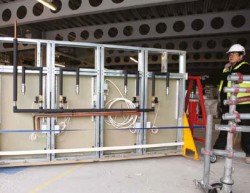As Managing Director of Cogent Consulting, Darren Richards is well placed to comment on how the world of offsite manufacturing has gained traction over the past 12 months. Here he shares his views on how the market is developing and which factors are influencing the sector.
The offsite manufacturing sector is an exciting place to be. We are seeing more inward investment than I have witnessed in my 25 years of working within the offsite arena. There are some acquisitions of existing players but primarily the investment is from new entrants and disruptors in to the space. This is making some of the mature and long-established businesses sit up and take notice.
The levels of confidence in the sector in respect of the long-term viability of offsite technology is greater than previously witnessed and is underpinned by the consistent and now joined-up messages from Government. Policies for procuring in
favour of offsite technology and being held to account by the recent House of Lords Select Committee Report, is changing the political landscape. Add to this, the rapid immergence of new private sector investments, especially in the housing industry and most notably within the Build to Rent (B2R) sector.
A number of significant procurement frameworks in the education and affordable housing sectors have also had major impact on changing the way offsite solutions are procured – in many instances with clients leaning heavily on the framework selection process to narrow down their technology and supplier options, thereby giving them more confidence to make the change.
Wider acceptance of offsite construction techniques will always be an ongoing challenge and the sector cannot afford to become complacent.
That said, the latest Cogent market statistics that we review on a half-yearly basis, indicate that offsite technology now has around a 12% share of total construction activity in the UK – which is a rise from circa 8% back as recently as 2015. Whilst this figure is a long way from reflecting the true potential of the sector, it is still significantly short of the declared 20-25% offsite construction activity that many of our contractor and developer clients are seeking, but most certainly heading in
the right direction.
Naturally, offsite penetration varies in different markets but if we look in particular at structural timber technology and its success in the low-rise residential sector, a market share of circa 30% can be measured, and the recent cost comparison report into timber and masonry – undertaken independently by Rider Levett Bucknall (RLB) – show that cost parity is being routinely delivered and in some instances, where DfMA has been truly embraced, timber frame as a build method is proving to be more cost-effective than masonry methods. This equation is likely to continue to develop further in favour of offsite technologies as the traditional industry skills crisis begins to harden in parallel to greater offsite manufacturing volumes and significant economies of scale. I do believe that with mature offsite technologies we are now genuinely at a tipping point
and a point of no return, where certain traditional construction methods will be eroded and eventually eliminated.
To read the full article in Offsite Magazine, go to the digital version of Issue 13 









